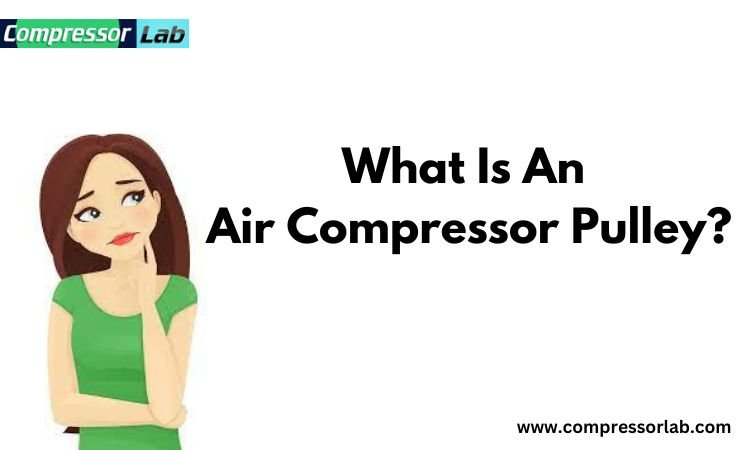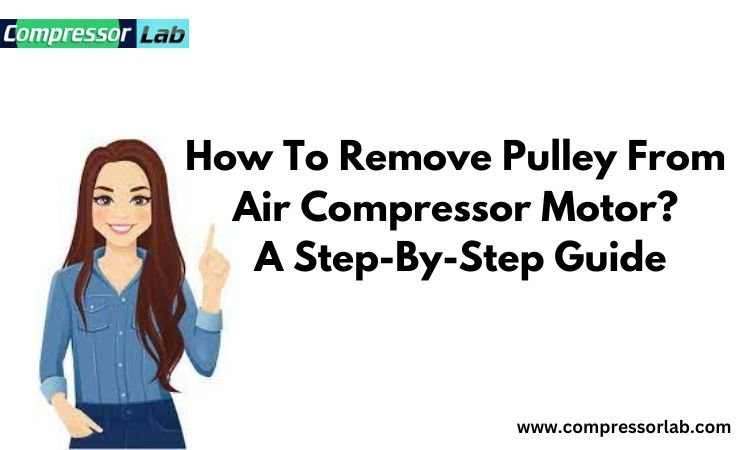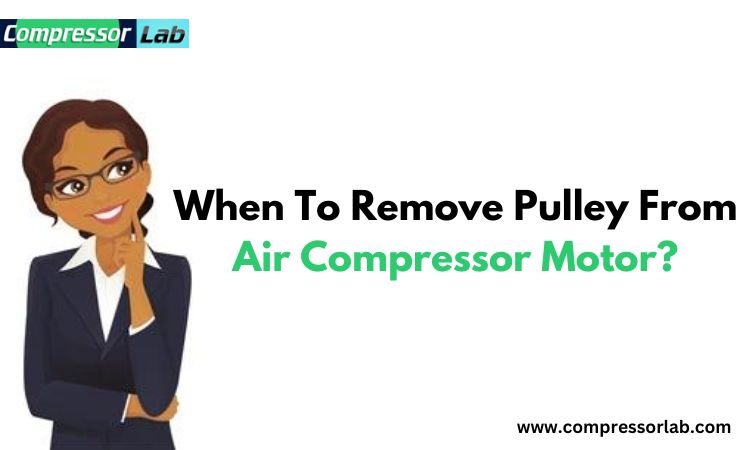
Pulleys are components of air compressors that transmit compressed air to close-located tanks. However, a common issue that air compressor users encounter is belt failure, which requires removing the pulley from the compressor.
So, how to remove the pulley from the air compressor motor, and is it something you can handle yourself? And what safety measures should you take? Hold on! I will discuss the whole thing here. Before we delve into this, let’s first establish what is an air compressor pulley first.
What Is An Air Compressor Pulley?

An air compressor pulley is an air compressor component responsible for driving the compressor pump. It is a rotating disc or wheel connected to the compressor motor shaft and the compressor pump shaft via belts or other power transmission devices.
The pulley transfers power from the motor to the pump, compressing air and sending it through the compressor’s outlet. The pulley’s size and ratio play a crucial role in determining the compressor’s efficiency and performance. A larger pulley will rotate slower than a smaller one, requiring less power to turn the compressor pump at the same speed.
Air compressor pulleys come in various shapes and sizes, depending on the compressor’s horsepower and design. They are typically made of cast iron, aluminum, or steel and designs to withstand high speeds and heavy loads. Also, the pulleys are designed with grooves or teeth to grip the belt, ensuring that the belt stays in place and transfers power smoothly.
How To Remove Pulley From Air Compressor Motor? A Step-By-Step Guide

Air compressors are an essential tool in any workshop or industrial setting. However, over time, the pulley on the motor of an air compressor may need to be removed for maintenance or replacement purposes. Removing a pulley from an air compressor motor may seem daunting, but it can be done quickly with the right tools and knowledge. In this step-by-step guide, I will describe removing a pulley from an air compressor motor.
Step 1: Safety First
Before removing the pulley from the air compressor, it is necessary to take appropriate safety protections. Make sure the device is unplugged and there is no electrical charge in the system. Additionally, wear protective gear such as safety glasses, gloves, and closed-toe shoes to protect yourself from hazards.
Step 2: Remove The Drive Belt
The first step in removing the pulley from an air compressor motor is to remove the drive belt. And the drive belt is responsible for transferring power from the engine to the compressor, and it needs to remove to access the pulley. To remove the drive belt, use a wrench to loosen the tension on the belt by turning the adjustment bolt. After the tension is disclosed, remove the belt from the pulley by sliding it off.
Step 3: Detach The Retaining Nut
Once the drive belt has been removed, the next step is to withdraw the retaining nut that holds the pulley in place. Use a socket or wrench to unlock the nut counterclockwise. It can be essential to use an impact wrench if the nut is too tight. Be alert not to harm the shaft threads while eliminating the nut.
Step 4: Use A Pulley Withdrawal Tool
After detaching the retaining nut, it is time to use a pulley removal tool. It designs to safely disconnect the pulley without damaging the shaft or the motor. And you can grip the pulley, which allows you to apply force without damaging any other components. Therefore, you can follow its direction to ensure proper usage.
Step 5: Remove The Pulley
With the pulley removal tool in place, apply pressure to separate it from the motor shaft. And separating the pulley may take some effort, but be patient and take your time to avoid damaging any components. When the pulley takes off, check it for any wear or damage and change it if needed.
Step 6: Reassemble The Components
When the pulley has been withdrawn and inspected, then you have to reassemble the components. Place the new pulley onto the motor shaft, and tighten the retaining nut by turning it clockwise. You can use a wrench to make sure that the nut tightens to the manufacturer’s specifications. Finally, reattach the drive belt by adjusting the tension bolt until the belt is snug.
Read also
Belt Drive vs Direct Drive Air Compressor: A Ultimate Guide(Opens in a new browser tab)
How to Remove AC Compressor Clutch? (Opens in a new browser tab)
How To Remove Water From Air Compressor? Ultimate Guide(Opens in a new browser tab)
How To Remove Water From Air Compressor? Ultimate Guide(Opens in a new browser tab)
Air Compressor Doesn’t Turn Off (11 Causes With Solution)(Opens in a new browser tab)
How To Inflate Car Tire At Home? Best Ways & Timesaving(Opens in a new browser tab)
When To Remove Pulley From Air Compressor Motor?

Over time, removing the pulley from the motor may become necessary for maintenance or repair. So, when should you remove the pulley from an air compressor motor? The answer to this question depends on a few factors, such as the type of maintenance or repair needed and the condition of the pulley and motor.
If you are performing routine maintenance on your air compressor, such as changing the oil or checking the air filter, you may not need to detach the pulley from the motor. However, if you are replacing the motor or the pulley, you must remove it from the engine.
Sometimes, you must remove the pulley if it is damaged or worn out. A damaged pulley can cause the belt to slip, affecting the compressor’s performance.
Therefore, you should immediately replace the pulley when you notice any signs of damage, such as cracks, chips, or worn grooves.
How To Choose Pulley For Air Compressor?

A pulley is a rotating machine’s part that helps transfer power from the motor to the compressor pump. You should consider various factors to select the right pulley for your air compressor. Such as–
The motor’s horsepower is the first factor to consider when choosing a pulley for your air compressor. The pulley should the size appropriately to match the horsepower of the motor. If the pulley is too small, the compressor pump may not receive enough power to operate at its maximum capacity. But when the pulley is too large, the compressor pump may receive too much power. And which could cause it to malfunction or even break down.
Another function is to check the speed of the motor. The pulley should size adequately to fit the speed of the engine. And the compressor pump can spin too fast when the pulley is too small. And this can cause it to malfunction and overheat. If the pulley is too large, the compressor pump may spin too slowly, reducing its efficiency and performance.
The type of compressor pump that you have is also a vital factor to check when choosing a pulley for your air compressor. Different types of compressor pumps require different types of pulleys. For example, a reciprocating compressor pump may require a different kind of pulley than a rotary screw compressor pump.
In addition to these factors, you should consider the size and type of belts you will use with the pulley. The pulley should be compatible with the belts you will use to transfer power from the motor to the compressor pump.
Final Words
Removing a pulley from an air compressor motor may seem intimidating, but it is a straightforward process that can be accomplished with the right tools and knowledge. Following these few steps, you can now securely remove the pulley, inspect it, and replace it if necessary. And it will ensure that your air compressor runs smoothly and efficiently.
Hopefully, now you don’t have any confusion and question about how to remove the pulley from the air compressor motor.
FAQs
Does pulley size make a difference in an air compressor?
Yes, the size of the pulley in a compressor can have an important effect on its performance. The pulley determines the speed at which the motor turns, affecting how much-compressed air the compressor can produce. A larger pulley will cause the motor to turn slower, decreasing the amount of compressed air. On the other hand, a smaller pulley will cause the engine to ride at a higher speed, increasing the amount of compressed air produced.
How do you remove a pulley from an air compressor belt?
To remove a pulley from an air compressor belt, you will need to follow a few simple steps. First, you will need to locate the tensioner bolt and loosen it with a wrench or socket. Once the tensioner loosened, you can slip the belt off the pulley. Next, use a pulley removal tool to grip the pulley and remove it from the compressor. Remember, during the process, it is important to be careful to prevent any harm or damage.


Recent Comments